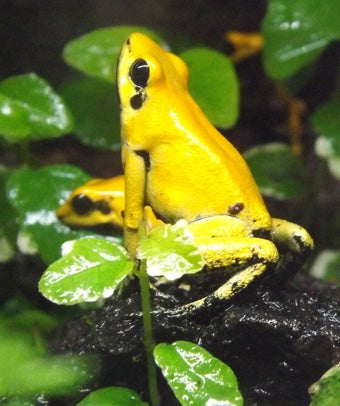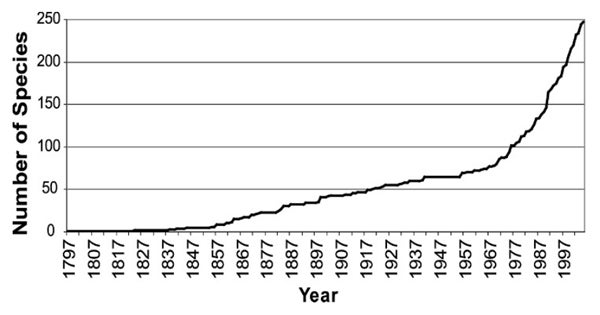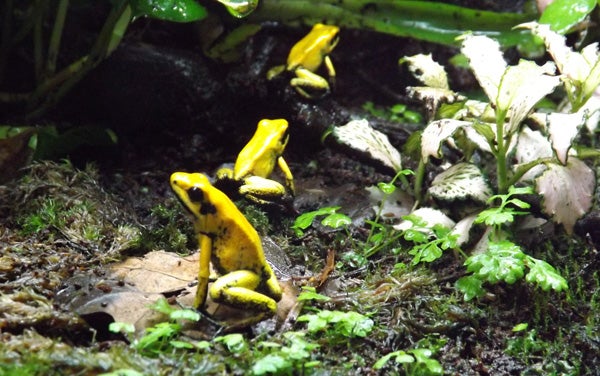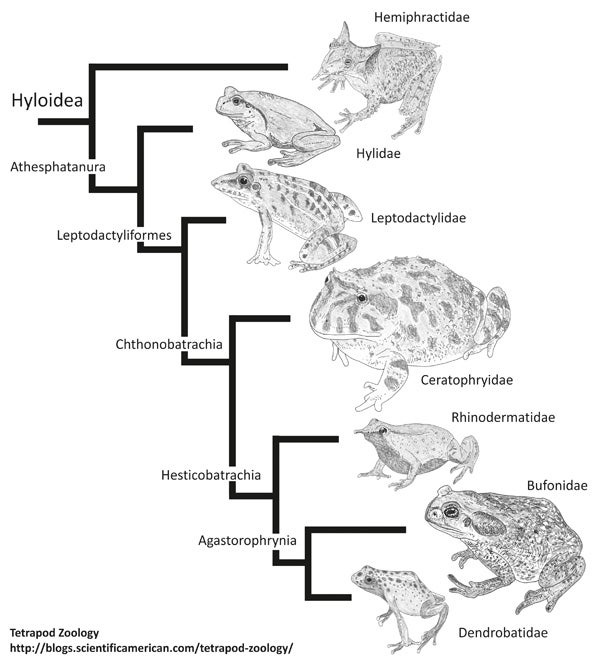This article was published in Scientific American’s former blog network and reflects the views of the author, not necessarily those of Scientific American
Regular readers will know that I try and cover anuran diversity as and when possible (anurans = frogs and toads). I’m always chronically limited by the availability of imagery: it’s really hard to write about obscure amphibians (and reptiles too), at least when you like your articles to be accompanied with a reasonable array of images.

Captive P. terribilis. Proof that frogs can, indeed, look up. Credit: Darren Naish
Anyway … today I want to talk briefly about Phyllobates terribilis, the Golden dart frog or Golden poison arrow frog. P. terribilis is just one of 185 species* of dendrobatids – the dart-poison frogs or poison dart frogs – but if you’ve read anything about frogs you’ll know this species because it’s always mentioned as the most poisonous of them all, and because it has an especially memorable name. Phyllobates terribilis means ‘terrible leaf walker’. However, it isn’t the only species of Phyllobates: five are currently recognised (an additional one or two exist but as are as yet unnamed). Incidentally, lots has changed in dendrobatid phylogeny and taxonomy in recent years, and some species once included in Phyllobates are now elsewhere, including in the colostethine genera Silverstoneia and Amereega. An enormous number of new species have been recognised in recent years: check out this graph from Grant et al. (2006)…
On supporting science journalism
If you're enjoying this article, consider supporting our award-winning journalism by subscribing. By purchasing a subscription you are helping to ensure the future of impactful stories about the discoveries and ideas shaping our world today.
* as of May 2017.

Accumulation of dendrobatid species 1797 to 2005, from Grant et al. (2006). Dendrobates tinctorius was the first to be named. Many of the species counted in this analysis are no longer within Dendrobatidae but included within other dendrobatoid lineages. Credit: Grant et al. 2006
P. terribilis is endemic to the rainforest of Pacific coastal Colombia. It’s social – typically occurring in groups of six or so – and is the largest dendrobatid of all, big females reaching 5.5 cm in SVL (snout to vent length). It seems to be reasonably intelligent for a frog and shows definite learning ability (Myers et al. 1978). Its bright yellow colouring is distinctive but some individuals are greenish or orange. P. terribilis is, of course, famous for being extremely toxic: on naming the species in 1978 (yes, it’s a relative newcomer to the scene), Charles Myers and colleagues described it as “at least twentyfold more toxic than other poison-dart frogs” (Myers et al. 1978) and described the use of its toxin in the blowguns of the Chocó Indians. They specifically named it terribilis to “[describe] the extraordinary toxicity of the frogs’ skin secretions, and [to allude] to the fear once evoked by the poisoned blowgun darts of a more warlike people”, and noted the significant advice they were given by local Chocó people as goes handling it. Their paper includes the brilliant line “we heeded the advice of our Indian friends and handled it with appropriate caution, especially after accidentally killing a few of their domestic animals that got into our contaminated garbage” (Myers et al. 1978, p. 312). The casualties referred to there were a chicken and a dog.

P. terribilis group in captivity. These are social, group-living frogs. Credit: Darren Naish
P. terribilis, in fact, the most toxic of known amphibians, and there are lots of great stats describing how the batrachotoxin it contains is powerful enough to kill some thousand humans per gram, and so on. Batrachotoxin (an alkaloid) is sequestered from an as-yet-unidentified arthropod, thought to most likely be a melyrid beetle based on the fact that these are the source of the batrachotoxins present in the birds Pitohui and Ifrita. The frogs are non-poisonous in captivity. The people of Chocó are the only ones who use blowguns where frog toxin is the sole ingredient, but the practise was said to be in decline even when Myers et al. (1978) wrote their (impressively extensive, very thorough) study. It would be interesting to know what’s happening today. The frog is not killed when its toxin is required (unlike some other dendrobatids, which are speared through the body); rather, a dart is rubbed across its back, sometimes while the frog is held close to a fire.

A highly simplified phylogeny for the frog clade Hyloidea (based on Frost et al. 2006, Grant et al. 2006 and Pyron & Wiens 2011). Dendrobatids are close kin of toads. The illustrations used here were produced for my still in-prep textbook (ON WHICH GO HERE). Credit: Darren Naish
Studies find Phyllobates to be part of the dendrobatid clade Dendrobatinae, and thus to be especially close to Adelphobates, Dendrobates, Minyobates and Ranitomeya (Grant et al. 2006). Dendrobatines are unusual compared to other dendrobatids in having smooth (rather than granular or spicular) dorsal skin and in being able to sequester the specific alkaloids that make them super-toxic. Dendrobatids are hyloids: part of the neobatrachian frog group that includes glassfrogs, treefrogs and true toads. Within this clade, they seem to be especially close to toads (Frost et al. 2006, Grant et al. 2006, Pyron & Wiens 2011), these groups being part of the hyloid clade Agastorophrynia. Within that clade, a few other, recently recognised (or ‘resuscitated’) groups – namely Hylodidae and Aromobatidae – are closer to dendrobatids than are toads.
For previous Tet Zoo articles on hyloid anurans, see...
The toads series comes to SciAm: because Africa has toads too
Frogs you may not have heard of: Brazil’s Cycloramphus ‘button frogs’
Refs - -